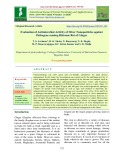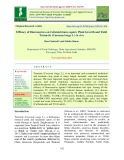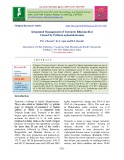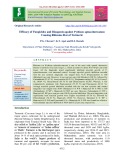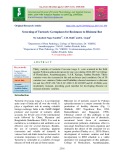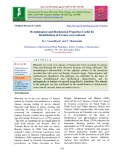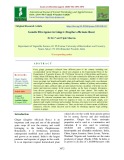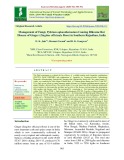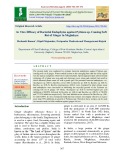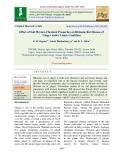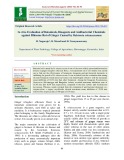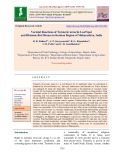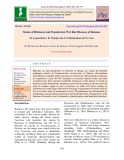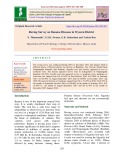
Rhizome rot
-
The study also revealed that the antifungal effects of silver nanoparticles are positively correlated to the concentration of nanoparticles as well as the time of exposure. Further, it can be exploited as an alternative for chemical management in the future.
 5p
5p  chauchaungayxua11
chauchaungayxua11
 23-03-2021
23-03-2021
 7
7
 1
1
 Download
Download
-
Turmeric (Curcuma longa L.), is an important and economical medicinal and aromatic crop, prone to many fungal, bacterial, viral and nematode diseases. The most important fungal diseases are leaf spot (Colletotrichum capsici), leaf blotch (Taphrina maculans), rhizome rot (Pythium aphanidermatum) etc.,
 8p
8p  chauchaungayxua11
chauchaungayxua11
 23-03-2021
23-03-2021
 8
8
 1
1
 Download
Download
-
Turmeric (Curcuma longa L) rhizome rot caused by Pythium aphanidermatum was one of the divesting disease and causes accountable losses. All fungicides, bioagents, botanicals and soil amendments (alone and in combination) tested in vitro for management of turmeric rhizome rot was found effective against P. aphanidermatum.
 7p
7p  trinhthamhodang1218
trinhthamhodang1218
 26-02-2021
26-02-2021
 10
10
 2
2
 Download
Download
-
The disease has been reported to causes more than 60 per cent mortality of seedlings both in nursery and field condition and about 50-80 per cent losses during storage (Nirmal, 1992); rhizome rot resulted in yield loss of 50% (Rajalakshmi et al., 2016).
 9p
9p  trinhthamhodang1218
trinhthamhodang1218
 26-02-2021
26-02-2021
 11
11
 1
1
 Download
Download
-
Thirty varieties of turmeric Curcuma longa L. were screened in the field against Pythium aphanidermatum for one year during 2016-2017 at College of Horticulture, Anantharajupeta, Y.S.R. Kadapa, Andhra Pradesh. These varieties were also screened in lab and net house (pot) condition. Out of 30 varieties two varieties (Salem and Prathibha) showed resistance to rhizome rot and five (TCP-129, VK-9, IC-330113, IC-033007 and IC-212606) were moderately resistant, providing good material for developing rhizome rot resistant turmeric varieties.
 9p
9p  cothumenhmong9
cothumenhmong9
 18-01-2021
18-01-2021
 11
11
 2
2
 Download
Download
-
Rhizome rot or tip over disease of banana has been occurring in serious form and affecting the yield wherever bananas are being cultivated. The morphological characteristics of the eighteen isolates of the bacterium revealed that cells were rod shaped, occurred singly, Gram negative and peritrichously flagellated. The pathogen was identified on the basis of cultural, morphological and biochemical characteristics and its pathogenicity in banana was proved using Koch‟s postulates.
 6p
6p  gaocaolon9
gaocaolon9
 22-12-2020
22-12-2020
 13
13
 2
2
 Download
Download
-
Forty turmeric genotypes collected from different parts of the country including two recommended varieties as checks viz. Palam Lalima and Palam Pitambar were planted at the Experimental Farm of the Department of Vegetable Science, Dr. YS Parmar University of Horticulture and Forestry, Nauni, Solan (HP) during Kharif season of 2011 and evaluated for different yield and yield contributing traits.
 9p
9p  trinhthamhodang1215
trinhthamhodang1215
 23-09-2020
23-09-2020
 11
11
 1
1
 Download
Download
-
Forty ginger genotypes collected from different parts of the country including one recommended variety Himgiri as check were planted, at the Experimental Farm of the Department of Vegetable Science, Dr. YS Parmar University of Horticulture and Forestry, Nauni, Solan (HP) during Kharif season of 2011 and evaluated for different yield and yield contributing traits.
 5p
5p  trinhthamhodang1215
trinhthamhodang1215
 23-09-2020
23-09-2020
 14
14
 1
1
 Download
Download
-
The Field experiments to evaluate the bio efficacy of available market ready fungicides combinations (NATIVO, SAAF, RIDOMIL) and combinations of fungicide viz: Copperoxycloride, Carbendazim, Mencozeb, chloropyriphos (Insecticide), Streptocycline (Bactericide) along with bio control agents (T. viride) was conducted at Talai village of Jhadol block of Udaipur district during year 2016-17 and 2017- 18 to find out an effective control measure against rhizome rot (Pythium aphanidermatum) disease of ginger (Zingiber officinale Rose).
 9p
9p  nguaconbaynhay7
nguaconbaynhay7
 15-08-2020
15-08-2020
 8
8
 1
1
 Download
Download
-
Rhizome rot and yellows caused by Fusarium oxysporum f. sp. Zingiberi, is a serious a serious soil-borne disease of ginger and found to be prevalent in the north-east region of India. Most of the plant disease resistance (R) genes encode a highly conserved nucleotide binding site and leucine-rich repeat structure (NBS-LRR).
 14p
14p  trinhthamhodang1213
trinhthamhodang1213
 29-05-2020
29-05-2020
 12
12
 0
0
 Download
Download
-
The present study was conducted to evaluate bacterial endophytes against Pythium spp. causing soft rot of ginger. Water soaked lesions at the emerging base and the collar region was the typical symptoms observed on infected plants. Sprout appeared pale yellowish and withering off of plant was seen and such rhizomes were rotten and emitted foul smell in which diseased plants came off with a gentle pull.
 8p
8p  cothumenhmong5
cothumenhmong5
 17-05-2020
17-05-2020
 14
14
 2
2
 Download
Download
-
Rhizome rot of ginger is both seed (rhizome) and soil borne disease and soil plays an important role in the disease incidence and severity. Soil physico chemical properties play an important role in disease severity of rhizome rot of ginger. Correlation studies of six soil physico-chemical parameters with disease incidence (DI) showed that Potash (K2O) content in soil was found exhibit significant negative correlation (-0.78). A ready to use regression equation has been developed to predict the incidence of rhizome rot disease in ginger with R2 value of 61 per cent.
 6p
6p  chauchaungayxua5
chauchaungayxua5
 08-05-2020
08-05-2020
 11
11
 0
0
 Download
Download
-
Bacterial wilt caused by R. solanacearum is one of the most widely spread and destructive disease of ginger (Zingiber officinale Rosc.). An experiment on in vitro studies was carried out to find out the effectiveness of botanicals, bioagents and anti-bacterial chemicals to inhibiting the growth of R. solanacearum.
 10p
10p  chauchaungayxua5
chauchaungayxua5
 05-05-2020
05-05-2020
 14
14
 1
1
 Download
Download
-
Bacteria producing biosurfactant molecules is beneficial to manage rhizome rot of turmeric caused by Pythium spp. A detailed study was conducted on biosurfactant producing bacteria for management of rhizome rot of turmeric. Initially, a survey was conducted to find out the incidence of the disease in turmeric growing of areas of Tamil Nadu, it was observed that rhizome rot in turmeric was also ranged from 9.16 to 71.55 and the maximum incidence was noticed in Ammampalayam (71.55%).
 10p
10p  angicungduoc4
angicungduoc4
 26-04-2020
26-04-2020
 7
7
 1
1
 Download
Download
-
Nine botanicals were evaluated for their antifungal activity against Fusarium solani causing root rot disease in Bael by employing poisoned food technique under laboratory conditions. The results indicated that all the botanicals inhibited the growth of the Fusarium solani as compared to control. Out of nine botanical tested, turmeric rhizome extract was found most effective as it showed minimum mycelial growth (33.3 mm, 20.7 mm and 13.5 mm) and maximum mycelial growth inhibition (63.1 %, 77.0 % and 85.
 7p
7p  angicungduoc4
angicungduoc4
 26-04-2020
26-04-2020
 6
6
 0
0
 Download
Download
-
Turmeric is one of the important spice crops grown in India. Root-knot nematode (Meloidogyne spp.) is a major problem, which causes galls/knots in the rhizomes and causes considerable yield loses. It also makes the way for the secondary infection by different pathogens like Pythium, Fusarium and Ralstonia in the soil. Yield losses due to nematode infestation are reported in turmeric-growing areas. A roving survey was conducted for incidence of root-knot nematode in turmeric during kharif season in 2016 at Belagavi, Bagalkot, Chamarajanagar and Kalburgi districts of Karnataka.
 10p
10p  trinhthamhodang4
trinhthamhodang4
 22-03-2020
22-03-2020
 10
10
 0
0
 Download
Download
-
Turmeric (Curcuma longa L.) is well known for its medicinal value, its cultivation is hindered by several diseases viz., leaf spot, anthracnose and rhizome rot. These diseases are managed by using the fungicides, which leads to development of resistant strains besides the environmental pollution and also the residue problem on final produce.
 7p
7p  caygaocaolon2
caygaocaolon2
 14-03-2020
14-03-2020
 8
8
 1
1
 Download
Download
-
Rhizome rot and pseudostem rot diseases of banana are caused by bacterial pathogens mainly of Pectobacterium carotovorum or Dickeya chrysanthemi individually or together and D. paradisiaca respectively. The bacterial rot diseases are reported to cause 40-70% incidence in severely infected fields and their occurrence has been reported worldwide.
 8p
8p  quenchua2
quenchua2
 18-12-2019
18-12-2019
 11
11
 1
1
 Download
Download
-
The roving suvey was conducted during 2016 to December 2017 and January 2018 at different places of Mysuru district on cultivars of Budubale, Ney Poovan, Grand Naine Nanjanagudu Rasabale and Nendran. Sigatoka leaf spot disease appeared in low to moderate form. The disease appeared severe form in Echagahally on Nanjanagudu Rasabale (56.76%). Freckle leaf spot appeared in low to moderate form. Incidence of Fusarium wilt ranged from 0.0 to 6.0% in Sept-October 2016, 0.0-2.86% in February 2017, 0.0-25.86% in August-September 2017 and 0.0-10.00% in December 2017- Jan 2018.
 6p
6p  quenchua2
quenchua2
 16-12-2019
16-12-2019
 5
5
 0
0
 Download
Download
-
On farm trials in ten locations were conducted to evaluate efficacy of IDM practices with emphasis on use of bio-control gents for management of rhizome rot in turmeric and to create awareness among the farming community on rhizome rot management during Kharif, 2014-15 to 2016-17 in the farmer’s fields in Krishna District of Andhra Pradesh.
 7p
7p  cothumenhmong1
cothumenhmong1
 11-12-2019
11-12-2019
 9
9
 0
0
 Download
Download
CHỦ ĐỀ BẠN MUỐN TÌM








